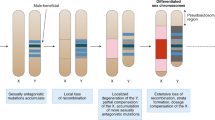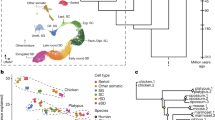Abstract
Most metazoans occur as two sexes. Surprisingly, molecular analyses have hitherto indicated that sex-determining mechanisms differ completely between phyla. Here we present evidence to the contrary. We have isolated the male sexual regulatory gene mab-3 (ref. 1) from the nematode Caenorhabditis elegans and found that it is related to the Drosophila melanogaster sexual regulatory gene doublesex (dsx)2. Both genes encode proteins with a DNA-binding motif3 that we have named the ‘DM domain’. Both genes control sex-specific neuroblast differentiation and yolk protein gene transcription; dsx controls other sexually dimorphic features as well. The form of DSX that is found in males can direct male-specific neuroblast differentiation in C. elegans. This structural and functional similarity between phyla suggests a common evolutionary origin of at least some aspects of sexual regulation. We have identified a human gene, DMT1, that encodes a protein with a DM domain and find that DMT1 is expressed only in testis. DMT1 maps to the distal short arm of chromosome 9, a location implicated in human XY sex reversal4. Proteins with DM domains may therefore also regulate sexual development in mammals.
This is a preview of subscription content, access via your institution
Access options
Subscribe to this journal
Receive 51 print issues and online access
$199.00 per year
only $3.90 per issue
Buy this article
- Purchase on Springer Link
- Instant access to full article PDF
Prices may be subject to local taxes which are calculated during checkout




Similar content being viewed by others
References
Shen, M. M. & Hodgkin, J. mab-3, a gene required for sex-specific yolk protein expression and a male-specific lineage in C. elegans. Cell 54, 1019–1031 (1988).
Burtis, K. C. & Baker, B. S. Drosophila doublesex gene controls somatic sexual differentiation by producing alternatively spliced mRNAs encoding related sex-specific polypeptides. Cell 56, 997–1010 (1989).
Erdman, S. E. & Burtis, K. C. The Drosophila doublesex proteins share a novel zinc finger related DNA binding domain. EMBO J. 12, 527–535 (1993).
Veitia, R. et al. Deletions of distal 9p associated with 46, XY male to female sex reversal: definition of the breakpoints at 9p23.3-p24.1. Genomics 41, 271–274 (1997).
Eicher, E. M. et al. Sex-determining genes on mouse autosomes identified by linkage analysis of C57BL/6J-YPOS sex reversal. Nature Genet. 14, 206–209 (1996).
Hodgkin, J. in The Nematode Caenorhabditis elegans(ed. Wood, W. B.) 243–279 (Cold Spring Harbor Laboratory Press, New York, (1988)).
Hodgkin, J. A. & Brenner, S. Mutations causing transformation of sexual phenotype in the nematode Caenorhabditis elegans. Genetics 86, 275–287 (1977).
Hodgkin, J. Agenetic analysis of the sex-determining gene, tra-1 in the nematode Caenorhabiditis elegans. Genes Dev. 1, 731–745 (1987).
Schedl, T., Graham, P. L., Barton, M. K. & Kimble, J. Analysis of the role of tra-1 in germline sex determination in the nematode Caenorhabditis elegans. Genetics 123, 755–769 (1989).
Ito, H. et al. Sexual orientation in Drosophila is altered by the satori mutation in the sex-determination gene fruitless that encodes a zinc finger protein with a BTB domain. Proc. Natl Acad. Sci. USA 93, 9687–9692 (1996).
Ryner, L. C. et al. Control of male sexual behavior and sexual orientation in Drosophila by the fruitless gene. Cell 87, 1079–1089 (1996).
Finley, K. D., Taylor, B. J., Milstein, M. & McKeown, M. dissatisfaction, a gene involved in sex-specific behavior and neural development of Drosophila melanogaster. Proc. Natl Acad. Sci. USA 94, 913–918 (1997).
Erdman, S. E., Chen, H.-J. & Burtis, K. C. Functional and genetic characterization of the oligomerization and DNA binding properties of the Drosophila Doublesex proteins. Genetics 144, 1639–1652 (1996).
Hodgkin, J. Male phenotypes and mating efficiency in Caenorhabditis elegans. Genetics 103, 43–64 (1983).
Spieth, J., Denison, K., Kirtland, S., Cane, J. & Blumenthal, T. The Caenorhabditis elegans vitellogenin genes: short sequence repeats in the promoter regions and homology to the vertebrate genes. Nucleic Acids Res. 13, 5283–5295 (1985).
Baker, B. S. & Ridge, K. A. Sex and the single cell. I. On the action of major loci affecting sex determination in Drosophila melanogaster. Genetics 94, 383–423 (1980).
Whitfield, L. S., Lovell-Badge, R. & Goodfellow, P. N. Rapid sequence evolution of the mammalian sex-determining gene SRY. Nature 364, 713–715 (1993).
Tucker, P. K. & Lundrigan, B. L. Rapid evolution of the sex determining locus in Old World mice and rats. Nature 364, 715–717 (1993).
Koopman, P., Gubbay, J., Vivian, N., Goodfellow, P. & Lovell, B. R. Male development of chromosomally female mice transgenic for Sry. Nature 351, 117–121 (1991).
Kuwabara, P. E. Interspecies comparison reveals evolution of control regions in the nematode sex-determining gene tra-2. Genetics 144, 597–607 (1996).
de Bono, M. & Hodgkin, J. Evolution of sex determination in Caenorhabditis: unusually high divergence of tra-1 and its functional consequences. Genetics 144, 587–595 (1996).
Wilkins, A. S. Moving up the hierarchy: a hypothesis on the evolution of a genetic sex determination pathway. BioEssays 17, 71–77 (1995).
Sulston, J. & Hodgkin, J. in The Nematode Caenorhabditis elegans(ed. Wood, W. W.) 587–606 (Cold Spring Harbor Laboratory Press, Cold Spring Harbor, New York, (1988)).
Mello, C. C., Kramer, J. M., Stinchcomb, D. & Ambros, V. Efficient gene transfer in C. elegans: extrachromosomal maintenance and integration of transforming sequences. EMBO J. 10, 3959–3970 (1991).
Hodgkin, J. More sex-determination mutants of Caenorhabditis elegans. Genetics 96, 649–664 (1980).
Sigurdson, D. C., Spanier, G. J. & Herman, R. K. Caenorhabditis elegans deficiency mapping. Genetics 108, 331–345 (1984).
Zarkower, D. & Hodgkin, J. Molecular analysis of the C. elegans sex-determining gene tra-1: a gene encoding two zinc finger proteins. Cell 70, 237–249 (1992).
Spieth, J., Shim, Y. H., Lea, K., Conrad, R. & Blumenthal, T. elt-1, an embryonically expressed Caenorhabditis elegans gene homologous to the GATA transcription factor family. Mol. Cell Biol. 11, 4651–4659 (1991).
Trask, B. in Genome Analysis: a Laboratory Manual(eds Birren, B., Green, E., Hieter, P. & Myers, R.) (Cold Spring Harbor Laboratory Press, Cold Spring Harbor, NY, in the press).
McDonald, M. T., Flejter, W., Sheldon, S., Putzi, M. J. & Gorski, J. L. XY sex reversal and gonadal dysgenesis due to 9p24 monosomy. Am. J. Med. Gen. 73, 321–326 (1997).
Acknowledgements
We thank colleagues at the University of Minnesota and MRC-LMB for discussions; M. de Bono for microinjection of cosmids from the mab-3 region and for discussion; K. Burtis for dsx cDNAs; A. Coulson, J. Sulston, S. Chissoe and the C. elegans Genome Sequencing Consortium for assistance with physical mapping and sequencing of the mab-3 region; C. Kenyon, C. Hunter and D.Cowing for the mab-3(mu15) allele; Y. Kohara for a mab-3 cDNA clone; M. Sanders for a human-tissue blot; E. Parker for technical support; and V. Bardwell, J. Heasman, H. Towle, B. Van Ness and C. Wylie for critical reading of the manuscript. Some of the work by M.M.S. was performed in the laboratory of I.Greenwald, whom we thank. This work was supported by grants from the Minnesota Medical Foundation, University of Minnesota Graduate School and the NIH to D.Z., by NSF predoctoral fellowships to C.E.S. and M.M.S., and by the MRC and the HHMI.
Author information
Authors and Affiliations
Corresponding author
Rights and permissions
About this article
Cite this article
Raymond, C., Shamu, C., Shen, M. et al. Evidence for evolutionary conservation of sex-determining genes. Nature 391, 691–695 (1998). https://doi.org/10.1038/35618
Received:
Accepted:
Issue Date:
DOI: https://doi.org/10.1038/35618
This article is cited by
-
Identification and characterization of the Dmrt1B gene in the oriental river prawn, Macrobrachium nipponense
Development Genes and Evolution (2024)
-
The function and evolution of a genetic switch controlling sexually dimorphic eye differentiation in honeybees
Nature Communications (2023)
-
PRC1 suppresses a female gene regulatory network to ensure testicular differentiation
Cell Death & Disease (2023)
-
Evolution of sex determination in crustaceans
Marine Life Science & Technology (2023)
-
Improved biomarker discovery through a plot twist in transcriptomic data analysis
BMC Biology (2022)
Comments
By submitting a comment you agree to abide by our Terms and Community Guidelines. If you find something abusive or that does not comply with our terms or guidelines please flag it as inappropriate.



